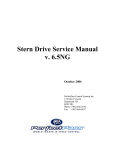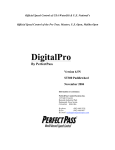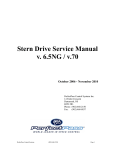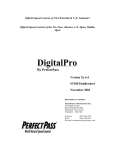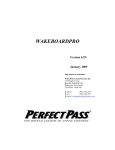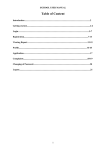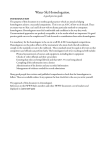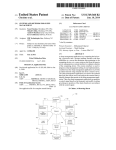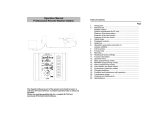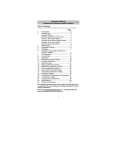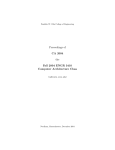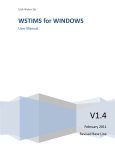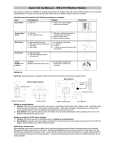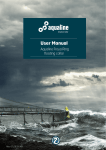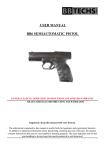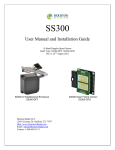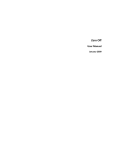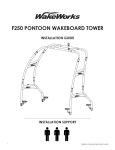Download PRO
Transcript
Official Speed Control of USA WaterSki & U.S. National’s Official Speed Control of the Pro Tour, Masters, U.S. Open, Malibu Open DigitalPro By PerfectPass User Manual Version 6.5NG June 2005 Information or assistance: PerfectPass Control Systems Inc. 14 Trider Crescent Burnside Industrial Park Dartmouth, Nova Scotia CANADA B3B 1R6 By phone (902) 468-2150 By fax (902) 468-8837 By email [email protected] TABLE OF CONTENTS Page Number Section 1 - Getting Started 1 Initial Setup Getting Familiar with PerfectPass Changing Modes Section 2 - Slalom Mode Using Slalom Mode RPM Based Slalom Speed Based Slalom Setting Baselines Additional Information & Settings Section 3 - Jump Mode 3 6 7 9 Using Jump Mode Jump Driving Additional Information & Settings Section 4 - Trick Mode 14 Using Trick Mode Trick Settings Section 5 - RPM Mode 16 Section 6 - Wakeboard Mode 17 Using Wakeboard Mode Wakeboard Settings Section 7 - Calibrating PerfectPass Speedometer (Trick /Wakeboard) 19 Section 8 - Integrated Timing 20 Using integrated Timing Placing Smart Timers Placing Magnets Section 9 - Magnet Test Mode 23 Section 10 - Addition Features 23 Screen Contrast Name List System Info Control Parameters (CS / CR) Override ON/OFF Device Test 23 24 APPENDIX All Ball Timing Information Warning: PerfectPass highly recommends you become familiar with the operation of your new boat prior to using the speed control. (Leave in OFF position). Once you are familiar and comfortable with the operation and handling of your boat, try the speed control in the different modes without a skier to familiarize yourself with its operation. If you feel it is not working properly or have questions, leave in the OFF position and contact PerfectPass or your dealer immediately. USER’S GUIDE Section 1. GETTING STARTED INITIAL SETUP - The display will guide you through this set up. Read slowly and carefully. Your new PerfectPass system must now complete a short set up procedure to familiarize itself with your particular boat and engine. (This may have been performed by your dealer if factory installed) Step (1) Engine Selection. On some systems you will be asked to select the engine in your boat. It will appear as [5.7L ^ = Yes]. This means if you have standard engine, press UP. For optional big block 6L or 8.1L, press DOWN. Step (2) The display will now show [read in MPH ^ = Yes]. It is asking you if you would like the display to operate in mph. If you do, confirm by pressing the UP key. If you want kph press the DOWN key. (We have selected mph for illustration purposes) Step (3) [WAKEBOARDPRO ^=Y] The display will now ask if want the system to be a WakeboardPro or a 3-event DigitalPro: For WakeboardPro Press UP, for DigitalPro press DOWN. Step (4) The display will now move into the Slalom mode, described in the next section. GETTING FAMILIAR WITH PERFECTPASS Turning System ON and OFF – All system functions require the PerfectPass control system to be powered up (ignition in ON or Accessory position). The ON/OFF key turns the PerfectPass control ON or OFF. The system requires the boat to be in neutral before turning the system ON or OFF. After pressing the ON/OFF key [IN NEUTRAL ^ =Yes] may appear to remind the driver, and confirm the boat has been returned to neutral. When PerfectPass is OFF it will not engage. Any time you operate your boat the system will be powered up, although it can be in the OFF mode. Every time you power up PerfectPass it will return to the last event and speed that was used. System ON System OFF Engaging System – With PerfectPass ON, the system will automatically engage once the SETPOINT is reached. PerfectPass requires the driver to bring the boat up to and slightly past the SETPOINT before it will engage. When the system engages it will sound an audible beep and the top line will become highlighted. In Slalom mode the screen appears as follows: Disengaging System – The PerfectPass system is unable to increase throttle position past the physical position of the throttle handle. This important feature gives the driver the power to over ride the system at any point by simply pulling back on the throttle. If the throttle handle is moved back past a point slower then where the system needs to be to control it will disengage and boat will be under manual control. Moving Around The Screen– The MENU key allows you to move around the screen to the various features. Any time you scroll to the Menu Arrow Icon the system is prompting you to press either the UP or DOWN keys to select or 1 confirm an option. Pressing the DOWN key on the brings you into a calibration screen. The calibration screen varies depending on the mode; the specifics of these screens will be covered within each mode description. Pressing the UP key on the brings you into the Mode Select Screen. MODE SELECT SCREEN To change modes press the MENU key until the desired mode is highlighted. Press the UP key to go into the highlighted mode. Press DOWN to go into the Mode’s background Setting Screens. DOWN key for Mode settings UP key to Select Highlighted Mode (Trick) SUBMENU SCREEN To enter the SUBMENU press the MENU and UP keys together, on any of the main mode screens. Contrast – To adjust the darkness of the lettering on the screen you can change the contrast. This value can be adjusted from 0-5 and is saved in the memory. The smaller the number, the brighter the screen will be in bright sun. If you turn your boat on but cannot see the screen, press MENU & UP Keys together and adjust contrast Up or Down. Name List – You can pull or enter a name from the name list here. The full description of the Name List is in Section 10 of the manual System Info – General system information can be found here. The software version, engine selection, system voltage and water temperature (not equipped on all boats) can be found here. See Section 10. ADDITIONAL FEATURES for more information on this feature. Device Test – This test allow you to test for proper control of the rope switches and for system troubleshooting. See Section 10. 2 Section 2. SLALOM MODE USING SLALOM MODE The Slalom mode is designed to give a skier an optimum and consistent pull through a Slalom course while producing perfect timing passes. This section covers the various Slalom Modes within the PerfectPass system. The main RPM based Slalom (36 mph – 24.9 mph) screen appears as follows: 2. Name/Mode/Crew 1. RPM Adjust 3. Menu Arrow 8. KX (Pull) 4. Speed/SETPOINT 7. PX (Rope) 6. Skier Weight 5. Course Times Tachometer As you press the MENU key you will move around the circle following the numbers above. 1. RPM Adjust This value directly adjusts the RPM/Speed value the system is trying to hold. If a time is fast or slow, you can enter an RPM value for the next pass. Example: A time was a little fast and PerfectPass suggested “-20 RPM”. Enter –20 on RPM Adjust. You may also use this in a headwind/tailwind situation. 2. Name/Mode/Crew Weight This section of the screen displays either the Mode, Slalom or a Skier’s Name pulled from the Name List. Press UP key to access the Name List: Name List is discussed in Section 10. Press DOWN key to access the Crew Weight Enter the Crew Weight in pounds using the UP and DOWN keys. Press the MENU key to confirm and continue. 3. Menu Arrow Press UP key to change modes or mode settings: Change between modes using Menu Key. 3 Press DOWN key to Calibrate system: The calibration screen is described below in this section on Page 6. 4. Speed/SETPOINT The speed readout will turn into the SETPOINT when the engine is below 1500 RPM or the Speed/SETPOINT is highlighted. When this is highlighted the metric conversion will appear in this area of the screen. Press UP or DOWN keys to select desired SETPOINT: 5. Course Times This section of the screen displays the timing information from the last pass. As well as the suggested RPM adjustment based on the times. These screens will scroll automatically at the end of each pass. The result of this check is shown to the right of the times as shown below. Tolerance Indicator = Good Times = Slow Times = Fast Times Full Course Error and Time 1st and 2nd Segment 1st and 2nd Segment Errors Suggested RPM Adjust With the times highlighted on the screen you can press the DOWN key to view the All Buoy Timing information. ABT All buoy times are displayed on one screen with full course error and full course time at the top. Press any key to return to main screen. 4 6. Skier Wight To enter or adjust skier weight simply highlight this section of the screen and press the UP or DOWN keys to make adjustments. The skier weight is entered in pounds, i.e. the above example shows a skier with a weight of 135 pounds. The skier weight is required so the PerfectPass system can apply the correct amount of RPM to compensate for their pull. ( 1 pound = 1 RPM). 7. PX (Rope Switch Setting) Factory setting is 0, which is the off position (typical values range from 5 – 10). If the optional Slalom Switch is used, this is the percentage of skier weight which is applied during each pull (i.e. A value of 10 would apply 20 rpm to a 200 pound skier). A value of 0 means no pull from the switch. 8. KX (Throttle Response) The KX value represents the throttle control response of the system. Under the current rules, a skier is encouraged to use the factory settings or normal (represented by an “n” on the screen), but has the option for a higher more immediate throttle response setting (+ or ++). As well they have the option for a lower KX (-). Tips: (1) (2) A shortcut to skier weight in Slalom Mode … press and hold MENU Key. Crew Weight Calculator – When crew weight is on screen, press UP and DOWN Keys together. 5 SLALOM CALIBRATION / SETTING BASELINES (Your new system must be calibrated for accuracy) 4. Menu Arrow 1. Quick Calibrate 3. Baseline 2. SETPOINT RPM Adjust Course Time Tachometer Your system must be calibrated for accuracy in a course. This is often called setting Baseline RPM Values. In slalom mode (without a skier) you must complete a timed slalom pass at each official speed you intend to use. This must be done in a course using magnets and Mag Sensor or a PerfectPass Hand Timer. Once calibrated, these new settings will be maintained in the system memory. Step 1. In Slalom Mode, enter accurate Crew Weight, set Skier Weight to 0 and RPM Adjust to 0. Step 2. Set speed (ex: 34.2) and engage system prior to course. Step 3. Mag Sensor will trigger at entrance gate, ball 3 gate and exit gate. (Alternatively, if using Hand Timer push button at same gate locations). Step 4. Stop boat, highlight Key and press Down to access “Quick Calibrate”. Press Up Key to confirm Quick Calibration request. System will confirm “Baseline and Speedometer Calibrated”. Step 5. After system confirms calibration at 34.2, change speed and repeat procedure. 23 MPH AND LOWER As you calibrate the various slalom speeds, you will note that 23 mph and lower are speed based. After you do a Quick Calibrate at 23 mph, you will be asked to perform a “Master Recal”. A yes to “Master Recalibrate” will automatically calibrate all other “under 23 mph” slalom speeds. (These under 23 mph speeds can be timed and calibrated independently for greater accuracy if desired). TOWING A SKIER (The Basics) Step 1. Enter Crew Weight, Enter Speed and Skier Weight. Step 2. Pull skier up and engage system prior to course. (You will hear an audible beep). Step 3. As you exit course review times on screen. If time was not perfect, the system will show an rpm suggested change. I.e. “+20 ADJUST”. You should enter an RPM Adjust value or 20 on main screen for next pass. This will speed up boat by 20 RPM. You may also use this feature in a headwind / tailwind situation. 6 ADDITIONAL SLALOM SETTINGS Additional Slalom Settings are accessed by pressing the UP key on the Main Slalom Screen with the highlighted. Then press the DOWN key when SLALOM is highlighted on the Mode Select Screen. The first two options can be accessed from the Main Slalom Screen as described above as well as here in the Slalom Settings Screen. Crew Weight – This setting can also be accessed on the main Slalom Screen as mentioned above on Page 3 or through the Slalom Settings screen. This value should be set to represent the total Crew Weight in pounds in the boat. It is essential this value be properly setup to ensure you get good times. Crew Weight Calculator - The system will add the weight of up to 3 individual crewmembers. Simply go to “Crew Adj” on the list, then press the DOWN and UP keys together, enter the weight of crew member #1, press MENU and do the same for crew member #2. The system will total the weight automatically. Calibrate – Press the UP key to enter the Baseline Calibration screen. This can also be accessed by pressing the DOWN key with the highlighted on the Main Slalom Screen. To check baselines, complete a timing pass and then go to this calibrate option. Press Up to enter Calibration Screen and then Up on Quick Calibrate to confirm calibration. SSB (Second Segment Balance) - The percentage of skier value driven RPM that is removed during the second segment to maintain an ideal time in slalom. Example: If your 2nd segment is running a little on the fast side relative to the first segment time, you would raise the SSB. The higher the value, the more RPM removed from the boat speed in the 2nd. Typical value is about 10. RPM OFFSET – Press the UP key on this feature to view and edit the 3 Offset values, 36, 34.2 and LWR. The lower (LWR) is used for all slower speeds. If you are finding that you are continually running less (or more) than a skiers weight to achieve a good time, you can enter an rpm offset value. The OFFSET value is only applied when a skier weight is entered. With a zero skier weight the OFFSET value has no effect. Example: On a typical boat with a skier’s actual weight entered, you have to run 25 less rpm to achieve an accurate time. If you are consistently seeing this, you can enter an offset rpm value (i.e.: -25) and the system will allow you to run all other values as you normally would. The offset value is independently set for 36.0, 34.2 and speeds 32.3-24.9 (LWR). RPM Offsets WT (Wait Time) - For tournament use to provide each skier the same wait time between passes. The number of seconds between passes (i.e. 40 seconds). Starts timing as boat exits the course. Two short beeps are indicated with 10 seconds left, followed by three long beeps when time is up. Previous Times – To reload the previous times simply highlight this item and press the UP key. The full course and segment times can be viewed from the Main Slalom Screen. The ABT’s can be viewed by pressing the DOWN key with the Timing Information highlighted on the Main Slalom Screen. 7 ADDITIONAL SLALOM INFORMATION Digital Speed Readout – The digital speedometer on the screen is for information only in RPM based Slalom. If you feel it is not reading accurately, go into Quick Calibrate feature after running any timed pass and press the UP key to recalibrate the speedometer. Setting Baselines / Calibrating Speedometer without a Course – If you do not have the benefit of a course, you can manually set baselines and calibrate the speedometer. This must be done at each slalom speed and you will require an accurate boat speedometer or GPS. Example: Starting at 36 mph, you engage system and note actual speed on the GPS is 35. Go into the Baseline Calibration screen and raise the RPM Baseline about 100 rpm. This will speed up the boat to about 36 (100 rpm = 1 MPH). If speed is now accurate, the final step is to calibrate digital speedometer. Note the digital speed readout and if it is reading 37, go into Speedometer Calibration Screen. Now press the DOWN key and lower speedometer calibration by one mph. Run boat again to confirm accuracy. Once the baseline and calibration is set, it will be saved within the system memory. Now change speed to 34.2 and repeat. All speeds you plan to use must be done. More Throttle – If you see the replace the on the Main Slalom Screen, the system is indicating it needs more manual throttle in order to maintain the speed. In this case just move the manual throttle forward a little. Comment [AA1]: This should be mentioned in a more general portion of the manual Smart Timer False Triggered - The Smart Timer is sensitive and will false trigger outside the course on waves, etc. To avoid false triggering, always slow the boat slightly to disengage the system after exiting the course between passes. The system will not false trigger if it is not engaged. (In the event the Timer does trigger before the course, press the UP key to reset Timer). CR – Control Setting - The “CR” value can be adjusted to improve engagement, lock in and control. (See page 23 for details). Recommended values: 2005 MasterCraft 1600 2006 MasterCraft 1950 Optional Slalom Switch - If you have a Slalom Switch, refer to detailed instructions sent with switch. The switch is beneficial to “short line skiers”. For full details, please contact PerfectPass, or log on to www.perfectpass.com. 8 Section 3. JUMP MODE USING JUMP MODE WARNING: (Timing must be used in Jump mode and a proper two segment jump course is required for system to work properly. Do not use PerfectPass in Jump mode without a proper course, integrated timing and experienced operator. Because the counter cut pull and cut to the ramp are different, you must have timing activated and running as the boat heads towards the ramp. The Jump mode is RPM based and therefore baseline values must be established just as in Slalom mode. Setting the jump baseline values must be done in a proper two segment jump course. Jump Letter must be set at A for this process. The Jump mode main screen will appear as follows: 2. Name/Mode/Crew/ New Jumper 1. RPM Adjust 3. Menu Arrow 8. S2 Fine 4. Speed/SETPOINT 7. S2 Percent 6. Jump Letter 1. 5. Course Times Tachometer RPM Adjust RPM adjust allows the driver to increase or decrease the overall times (1st & 2ng segment) by putting in a positive or negative RPM adjustment. Example: If the times are running consistently slow on both segments, you could add a value such as +20 rpm and the speed will be increased. You may wish to do this for a particular jumper (a heavy puller) or for a number of jumpers if the times are drifting in a certain direction 2. Name/Mode/Crew/New Jumper This section of the screen displays either the Mode Name or a Skier’s Name pulled from the Name List. Press UP key to access the Name List: Name List is discussed in Section 10. Press DOWN key to access the New Jumper and Crew Weight Press the UP key to enter a new jumper or DOWN key to enter or edit the crew weight. New Jumper is covered below. 9 Enter the Crew Weight in pounds using the UP and DOWN keys. Press the MENU key to confirm and continue. 3. Menu Arrow Press UP key to change modes or mode settings: This allows you to change modes and mode settings. The Additional Jump Settings will be discussed below. Press DOWN key to Calibrate system: The calibration screen is described below in this section. 4. Speed/SETPOINT The speed readout will turn into the SETPOINT when the engine is below 1500 RPM or the Speed/SETPOINT is highlighted. When this is highlighted the metric conversion will appear in this area of the screen. Press UP or DOWN keys to select desired SETPOINT. 5. Course Times This section of the screen displays the timing information from the last pass If Jump Letter is set to A and RTB, the second segment error from Return to Baseline will be displayed after segment errors as seen below: Tolerance Indicator = Good Times = Slow Times = Fast Times 1st and 2nd Segment 1st and 2nd Segment Errors 2nd Segment Error from Return to Baseline Times 10 6. Jump Letter The Jump Letter is a combination of Jumper Weight, Jumper Distance and ability. . This Jump Letter represents how much throttle will be applied once the Rope Switch is closed as the skier pulls. The higher the Jump Letter selected the more aggressive the pull will be. If you are unsure what Jump Letter you should use then start by using the ‘New Jumper’ feature as described below. This will automatically generate a Jump Letter based on your weight and distance. 7. Second Segment Percent (S2%) This is a percent of the Jump Letter RPM that is applied once the boat enters the 2nd segment. Under IWSF and AWSA rules, the boat is permitted to speed up in the 2nd segment. The higher the number, the more the boat will accelerate. A typically value for S2% is +60, the higher the value, the faster the 2nd segment. Example: If the 1st segment times are good, but the 2nd is a little slow, you would raise the number. S2 RTB – Works similar to S2%. Used when “Return to Baseline” is selected. Only applicable if skiers are activating switch and use a Jump Letter of J or higher. 8. Second Segment Fine Adjust (S2 Fine) This adjustment allows the driver to effectively fine adjust the 2nd segment only. It comes set at 0, which means a neutral effect. A number such as 30 would increase the 2nd segment by 30 rpm. Higher number speeds up the second segment. If skier does not trigger switch or has a letter less than J, S2 fine should be used to speed up second segment. Example: A jumper that does not cut and does not fully activate the switch may require extra rpm in the 2nd segment to keep the 2nd segment in tolerance. (In this case, S2 Fine is more effective than S2%). Entering a New Jumper – To enter a new jumper highlight the NAME/MODE/CREW/NEW JUMPER section of the screen and press the DOWN key. Then press the UP key to confirm you would like to enter a New Jumper. You will be asked to enter and answer the following information after which a Jump Letter will be calculated for you and displayed on the main screen. Move to the next selection by pressing MENU. Select desired SETPOINT Enter jumper weight in pounds Enter typical jumping distance in feet Toggles between Fast Second Segment and Return to Baseline to the right of the Jump Letter. Return to Baseline (RTB) – If you selected Return to Baseline the screen will show When RTB is selected the boat speed will immediately go to the baseline value as boat enters the second segment. If you have a skier using the switch with a value of J or higher, you can enter an S2 value which is a % of switch driven RPM. A setting above 0 will speed up boat in second segment if required to balance times. (This is similar to S2% used when Faster 2nd Segment is selected). Fast 2nd Segment – If you selected to run the fast 2nd segment, the screen will show Comment [AA2]: Same thing here I need a leason on how this workds to the right of the Jump Letter. Calibrating RPM Baselines - You can set RPM Baseline values for all of the official jump speeds (28, 29.8, 31.7, 33.6, and 35.4) or just the ones you use regularly. Let us assume you wish to set up 33.6 mph (54 kph). Enter the SETPOINT of 33.6 mph by pressing the MENU key until the ‘Speed/SETPOINT’ section of the screen is highlighted, then adjust the SETPOINT to 33.6 = 54K. Set the Jump Letter to A. Now bring the boat smoothly up to the SETPOINT to engage the system. (The system engages as soon as the default RPM Baseline value is reached, the NAME/MODE section will become highlighted, and an audible beep will sound). Enter the jump course and time both segments. As you exit the course the 11 times will be displayed and then the difference from actuals. The display screen will show the 33.6 mph times. The jump letter is set at A, RTB (return to baseline times are used). An example of this is shown in JUMP TIMING screens shown earlier in this section. If the times are not in tolerance or close to actuals then the RPM Baseline values will require adjustment. The easiest way to do this in Jump mode is to go to Quick Recalibrate by pressing the DOWN key with the highlighted. This will bring you to the Calibration screen as seen below. 4. Menu Arrow 1. Quick Calibrate 2. SETPOINT 3. Baseline RPM Adjust Course Time Tachometer Press the UP key on the Quick Calibrate message to recalibrate the baseline based on the times recorded from the last pass. In this example it is suggesting your RPM Baseline should be increased by 135 rpm. When you perform a Quick Calibrate the suggested adjust of 135 will be added to the baseline and saved in memory. The system will also calibrate the digital speedometer if the times are with in the “OK” tolerance. Now engage system and time boat again. If the times are still not close enough, repeat above steps until accurate. If you wish to set up RPM Baseline values for other speeds (i.e. 31.7 mph), change the SETPOINT and repeat the above steps. JUMP DRIVING WARNING – Using the Jump mode with Jump Switch is for experienced drivers and skiers only. Please read carefully prior to operating. The pull is very aggressive and designed for tournament water skiers only. You MUST have integrated timing and a proper jump course for system to operate properly. Assuming the RPM Baseline values have been accurately set, you are now ready to tow skiers. First enter your Jump Letter or enter a “New Jumper” as explained above. The Jump Letter can be changed by pressing the UP or DOWN keys with the Jump Letter highlighted on the screen. The key to a good pull and good times is to get the correct Jump Letter. If the pull to the ramp is solid and the first segment time is good, you know the Jump Letter is OK. If the time on the 1st segment was slow, you will require a higher letter on the next pass and vice versa. (Once engaged, push handle to full open position to allow PerfectPass room to throttle up when pulling long distance jumpers). If the first segment time was good, but the 2nd was slow, raise the S2%. Important Note: If the timer is triggered prior to entering the course, it must be reset by pressing the UP key. Failure to reset will result in an improper pull to the ramp. ADDITIONAL SETTINGS Additional Jump Settings are accessed by pressing the UP key on the Main Slalom Screen with the highlighted. Then press the DOWN key when JUMP is highlighted on the Mode Select Screen. The first three options can be accessed from the Main Slalom Screen as described above as well as in the Jump Settings Screen. 12 Crew Weight – This setting can also be accessed on the main Slalom Screen as mentioned above or through the Jump Settings screen. This value should be set to represent the total Crew Weight in pounds in the boat. It is essential this value be properly setup to ensure you get good times. Crew Weight Calculator - The system will add the weight of up to 3 individual crewmembers. Simply go to “Crew Adj” on the list, then press the DOWN and UP keys together, enter the weight of crew member #1, press MENU and do the same for crew member #2. The system will total the weight automatically. Calibrate – Press the UP key to enter the Baseline Calibration screen. This can also be accessed by pressing the DOWN key with the highlighted on the Main Jump Screen. New Jumper – Details for entering a new jumper are outlined above. This should be used when unsure what Jump Letter to select. CT (Counter Cut Time) - The maximum length of time the system will throttle once the skier pulls and closes the switch on the counter cut. Example: a value of 175 is 1.75 seconds and may be used in a tail wind. In a head wind you may want a longer pull so you could move it to 200 – 220 (2.0 – 2.2 seconds). The factory default is 190, or 1.9 seconds. x8u and x8d - These settings were always riding in the software, but were not adjustable values. With the higher horsepower engines and strong props being produced, these values are available for adjustment if needed for high-end jumpers. x8u – Represents the rate of throttle up on counter cut and cut for ramp once switch is activated. The larger the value, the softer the start will be. In other words, the pull will not be as aggressive on the start, but more gradual. The smaller the value, the more aggressive it will throttle up as switch closes. Example: A strong 6 Litre engine may need a larger X8u to avoid a strong initial pull as switch closes. x8d – Represents the rate of throttle down once skier stops pulling. The higher the value, the slower (softer) the throttle will return. The lower the value, the more aggressive it will throttle back. Example: If a boat was not slowing quickly enough in the 2nd segment, you would lower the value. Typical values 2006 Promo Boats with DBW PerfectPass 5.7L 6.0L x8u x8d 85 275 650 275 ADDITIONAL INFORMATION Jump Switch - For details on the optional Jump Switch (Slalom Switch) contact PerfectPass or log on to www.perfectpass.com . Jump Settings New Times (Faster Second Segment) Examples for when towing jumpers over 120 Feet. Jump Settings S2% S2 RTB CT Ski Nautique Faster 60 – 120 Faster 10 190 MasterCraft Faster 60 – 120 Faster 10 190 Malibu Faster 60 – 120 Slower 5 190 Others Faster 60 – 120 Slower 5 190 Important Tip: Once engaged, the throttle handle should be pushed forward to provide the system with room to throttle up. For long distance jumpers, it should be moved to full open. 13 Section 4. TRICK MODE USING TRICK MODE The trick mode is controlled via the speed signal from the paddle wheel. (You simply select the desired speed and go. RPM values are not used and no other settings are required) The main Trick screen will appear as: 2. Name/Mode 3. Menu Arrow 1. SETPOINT Mode Indicator Speed Tachometer 1. SETPOINT The speed at which would like the boat to engage and control. This number is adjusted in 0.1 mph (0.2 kph) increments. It can be adjusted while engaged (“on the fly”), or before it is engaged. 2. Name/Mode/Crew This section of the screen displays either the Mode Name or a Skier’s Name pulled from the Name List. Press UP key to access the Name List: Name List is discussed in Section 10. 3. Menu Arrow Press UP key to change modes or mode settings: As mentioned above this allows you to change modes and mode settings. The setting for the Trick mode will be discussed below. Press DOWN key to go to Speedometer Calibrate screen (Speedo Cal): TRICK DRIVING Using Trick mode is relatively easy. Turn control ON, select the desired speed and drive smoothly to the SETPOINT so PerfectPass can seamlessly take over. If you accelerate aggressively past the SETPOINT, it will take the system several seconds to lock in the speed. 14 You should keep your hand on the throttle to ensure it does not pull back and disengage the system. If you see the “#” sign on the screen, this indicates the system needs a little more manual throttle. If the skier falls, pull back on the throttle to disengage system. Slowly return to skier and pull them back up again. System will take over automatically once SETPOINT is reached. Speed changes can be made “on the fly”. When you are finished with the speed control, go to neutral and press the ON/OFF key. TRICK SETTINGS Trick Settings are accessed by pressing the UP key on the Main Trick Screen with the DOWN key when TRICK is highlighted on the Mode Select Screen. highlighted. Then press the Calibrate – Used to calibrate the PerfectPass digital speedometer readout. The procedure for adjusting this can be found in the Digital Speedometer Calibrate Section 7, Page 19. The calibration screen can also be accessed from the Main Trick Screen by pressing the DOWN key with the highlighted. Kd – This adjustable parameter controls the “firmness of the Pull”. Higher the number, more aggressive the pull. Normal range 14 – 18. NN (Paddle Filter Factor) – NN is set at 120 and represents the “Filter Factor” of the paddle. The higher the value, the more speed samples are taken from the Paddle prior to speed adjustment. It is rare for NN to require adjustment from Factory setting. If you believe your system is more “nervous” than it should be, try raising the NN. If the speed is floating too much, try lowering NN. This value is shared with Wakeboard Mode. Adjustments made in either mode will change the value in both modes. CS (Control Setting) This controls how well your system engages. (MENU and UP Key to control settings). See Section 10 for details. 15 Section 5. RPM MODE USING RPM MODE In this mode, the screen will appear as follows: 2. Menu Arrow 1. SETPOINT Mode Indicator Speed Tachometer Operating in this mode is very similar to using the Wakeboard or Trick modes, except the system is now controlling to an RPM SETPOINT. RPM DRIVING Prior to towing the rider / skier, select the RPM SETPOINT by using the UP or DOWN keys with the SETPOINT highlighted on the screen. Pull the rider up smoothly and continue to accelerate up to or beyond the RPM SETPOINT so the system can engage and take control. Changes can be made to the RPM SETPOINT while the system in engaged (“on the fly”) to fine-tune the RPM you desire. Note: You cannot enter “Names” in this mode. 16 Section 6. WAKEBOARD MODE USING WAKEBOARD MODE This is a speed-based mode using the paddlewheel to control similar to the TRICK mode. The Main Wakeboard Screen will appear as follows: 2. Name/Mode 3. Menu Arrow 1. SETPOINT Mode Indicator Speed Tachometer 1. SETPOINT The speed at which would like the boat to engage and control. This number is adjusted in 0.25 mph (0.5 kph) increments. It can be adjusted while engaged (“on the fly”), or before it is engaged. 2. Name/Mode/Crew This section of the screen displays either the Mode Name or a Skier’s Name pulled from the Name List. Press UP key to access the Name List: Name List is discussed in Section 10. 3. Menu Arrow Press UP key to change modes or mode settings: As mentioned above this allows you to change modes and mode settings. Press DOWN key to go to Speedometer Calibrate screen (Speedo Cal): Details Section 7. DRIVING WAKEBOARD Select the desired SETPOINT by pressing the UP or DOWN keys. Pull the rider up normally and accelerate smoothly up to or slightly beyond the target speed. Once PerfectPass sees the actual speed reach the SETPOINT it will automatically take control and will notify you of this with an audible beep. (Top line will become highlighted during engagement). 17 While in engaged the WakeboardPro should hold a smooth steady speed in a straight course down the lake. The driver should keep their hand on the throttle for safety, and to prevent it from pulling back on its own which will cause PerfectPass to disengage. The key to driving is to smoothly drive to the SETPOINT so the system can seamlessly take control. If you accelerate aggressively past the SETPOINT it will hunt around for several seconds before settling in. You will hear an audible beep when the system automatically takes control. If the rider falls, simply pull back on the throttle and the system will disengage. To Disengage System: If the rider falls simply slow the boat down. This will disengage speed control. Return to rider slowly and pull up again. System will once again take over when SETPOINT is reached. Turns / Over-riding the system: As the boat enters a turn, the engine RPM may increase to keep the craft at the SETPOINT. If the driver would like less throttle (so the rider does not get whipped) then simply pull back some on the throttle and help the system maintain a safe speed. As you complete the turn, move the throttle gently forward and the system will re-take control. (The driver can override the system at any time by pulling back or advancing the throttle). Wake Surfing in Wakeboard mode is excellent in the 9 – 11 mph range. Prior to using your boat for wake surfing, check with your boat builder or dealer to confirm it is safe for this sport. WAKEBOARD SETTINGS Wakeboard Settings are accessed by pressing the UP key on the Main Wakeboard Screen with the press the DOWN key when WAKEBOARD is highlighted on the Mode Select Screen. highlighted. Then Calibrate – Used to calibrate the PerfectPass digital speedometer readout. The procedure for adjusting this can be found on Page 19. The calibration screen can also be accessed from the Main WAKEBOARD Screen by pressing the DOWN key with the highlighted. KdW (Pull Characteristic) - KdW can be changed using the UP or DOWN keys with it highlighted on the screen. Higher values = more aggressive control response. Factory setting is 80. (Example: Heavily loaded boats may need a higher value to maintain a steady, crisp pull. Try 100– 150). After adjustment, press MENU to proceed. (Maximum recommended setting 200). NN (Paddle Filter Factor) – NN is set at 120 and represents the “Filter Factor” of the paddle. The higher the value, the more speed samples are taken from the Paddle prior to speed adjustment. It is rare for NN to require adjustment from Factory setting. If you believe your system is more “nervous” than it should be, try raising the NN. If the speed is floating too much, try lowering NN. This value is shared with Wakeboard Mode. Adjustments made in either mode will change the value in both modes. (Normal range 80 – 150). NOTE: CS (Control Setting) This controls how well your system engages. (MENU and UP Key to control settings). See Section 10 for details. 18 Section 7. CALIBRATING PERFECTPASS SPEEDOMETER (Trick / Wakeboard) If your digital speedometer is not accurate, you can go into the Speedo Cal screen of the system. This is accessed by pressing the DOWN key with the highlighted on the: • Main Trick or Main Wakeboard Screen – Trick and Wakeboard Modes Paddlewheel Factor 2. Menu Arrow SETPOINT 1. Calibration Adjust Speed There is one speedometer calibration value for Wakeboard and Trick Modes: (If you calibrate in Trick Mode, Wakeboard is adjusted as well). If you calibrate, we recommend you do so at 20 mph . With the Calibration Adjust highlighted on the screen press either the UP or DOWN keys to speed or slow the boat. CASE 1: Boat speedometer reading lower then PerfectPass Speedometer Press the UP key until the boat speedometer matches the PerfectPass speedometer CASE 2: Boat speedometer reading higher then PerfectPass Speedometer Press the DOWN key until the boat speedometer matches the PerfectPass speedometer When the speed readout matches the boat or reference speed press MENU once to highlight the then press the UP arrow to return to main screen. Example: If you are set and engaged at 20 mph, but the analog speedometer or GPS is reading 22 mph, go into the Speedo Cal screen and press the DOWN key several times until the boat speed drops to 20 mph so the PerfectPass Digital Speedometer matches the GPS or boat’s speedometer. Paddlewheel Factor – This value is the actual calibration value much like an RPM baseline. This number can be used to quickly determine where the calibration is at when troubleshooting the paddlewheel. This number is also very useful when trying to set calibration to match another system or to reset the calibration after a system RESET had been performed. 19 Section 8. INTEGRATED TIMING USING INTERGRATED TIMING An integrated timing system is another unique feature of PerfectPass. This timing system is set up for both the Slalom and Jump modes. For tournament skiing and in Jump mode timing must be used and be interfaced into the Master Module for PerfectPass to work properly. The system has been loaded with the USA Water Ski / I.W.S.F. Record Capability time tolerance chart for the Slalom and Jump modes. At the end of each timed pass the display will briefly display the full course time. It will then show the 1st and 2nd segments and variance from actual. To review the times again, simply press the MENU button to highlight the timing section of the screen. The system always resets after a few seconds. If the skier has fallen or the run has ended early, PerfectPass will know and resets. PerfectPass All Ball Timing – Our simplified “All Ball Timing” Method 4 is also loaded on this DigitalPro System. For operating details, see information in the Appendix at rear of manual. All Ball Timing is for tournament use only, and is not required for daily practice. Hand Timer - The optional Hand Timer is used much like a stopwatch when you do not have magnets in your course. As you enter the course press the button, then again at the ball three timing gate and again at the exit gate. If you have a Smart Timer & magnets, the timer will pick up each magnet automatically and an audible beep will be heard. Smart Timer - If you have a Smart Timer magnetic sensor and magnets you will not require the Hand Timer. The Smart Timer plugs into Timer 1 or Timer 2 input jack on the Master Module. If you do not have magnets in your course, disconnect the Smart Timer and plug the optional Manual Hand Timer into Timer 1 or Timer 2. If you have magnets and a Smart Timer, you do not require the Hand Timer. PLACING SMART TIMERS The sensor should be placed as close as possible to the outside of the boat. Typically the sensor is beside and under the passenger seat in a dry location. The Velcro should hold it firmly on the carpet. Place the timer in the direction as indicated on the Timer label to match the polarity of the magnets. If you are using 2 Smart Timers they should be lined up evenly so they are across from each other in the boat. In tournament use it is recommended that two Smart Timer pick-ups be used. One will be plugged into Timer 1 and the other into Timer 2. Both Timers should be used to test the strength and polarity of jump magnets. Note: For the jump event and for all buoy timing (ABT) you may require two Smart Timers, one located on each side of the boat. Both will plug into the Master Module. If using one Smart Timer you may have to move it to the driver’s side depending on where your magnets are located. Note: Some two way radios operating from the towboat can activate the timing system. In tournament conditions only press the talk button and communicate with shore officials before the boat is up to SETPOINT and after it has exited the course. Note: Whether using the Hand Timer or Smart Timer magnetic sensor, they will not operate or register a signal unless the boat is up to SETPOINT and system has engaged. This feature helps to avoid false triggering. Note: Smart Timer is designed for tournament skiing under tournament conditions. In other conditions such as lake cruising it will likely false trigger if you engage the system in Slalom or Jump mode. In this case you may wish to disconnect the Smart Timer when not in tournament like conditions. False Triggering - To reduce the chance of false triggering, drive a few miles per hour below the SETPOINT after exiting the course and during the turning route between passes. If you are not dropping skiers between passes do not fully accelerate to SETPOINT until you have passed through the boat wakes from the previous pass. (Smart Timer will not accept signals until speed control is engaged). In the event the timer false triggers outside the course and system is engaged, press the UP key to clear timer. 20 INSTALLING COURSE MAGNETS Magnets should be placed as close to the surface as possible for the most accurate and reliable timing. It is very important that all timing magnets in a given course have similar field strengths and all have the same polarity (North Pole facing up). With the same polarity each magnet will generate the timing trigger pulse exactly at the centerline of the timing buoy. A reversed magnet causes this trigger point to move towards the oncoming boat, this change in trigger location can be as much as four feet. At the higher boat speeds these timing errors can cause a perfectly in tolerance pass to become an out of tolerance re-ride. With a reversed magnet this error is also affected by boat path, depending upon which magnet is reversed either one or both timing segments can be affected. If you are unsure about the actual polarity of your magnets and are not getting the REV message, then make a pass with the Smart Timer arrow pointing towards the bow and make a note of the values displayed. Then reverse the direction of the Smart Timer sensor by pointing it towards the stern and make another pass in the same direction. The correct direction to point the Smart Timer is the direction, which produces the largest field strength values. Jump Magnets: It is very important that no other magnets are present in the course other than the official jump course magnets. For example, if the jump course runs next to the slalom course any slalom course magnets that could trigger the jump timer should be removed. For quality magnets contact PerfectPass at (902) 468-2150. 21 Section 9. MAGNET TEST MODE TESTING MAGNETS This mode allows you to test the timing magnets in the slalom and jump course for field strength and polarity. This mode uses a set RPM value (approximately 3080 rpm) to control. If you are running “All Ball Timing” or are in the jump mode, you should check that both of the Smart Timers are detecting properly, to do this you may need to drive the boat beside the course to test each sensor alone. Your test can and should be done in both directions through the course. The boat is brought up to the set RPM to engage the system and the boat is driven through the course. After engagement the screen should appear as follows: Drive a split boat path and note the magnet strength readings. After passing two magnets using 2 Timers the system could display a message similar to the following: Mode Magnet Strength 1. Menu Arrow Magnet Count 2. Clear Magnets Polarity Timer Number Timer Number- indicates the timer which has been triggered (labeled on Master Module “Timer 1” or “Timer 2”). Polarity -the direction of the magnet. In the above example Magnet#0 is “-“ Magnet#1 is “+”. This indicates the magnet is pointing in the wrong direction relative to the Smart Timer. If the polarity is “-“ you should review the ‘Placing Magnets’, Section 8 information and make the appropriate changes to the magnet. NOTE: A very large or strong magnet can saturate the sensor and cause the “-” message to occur incorrectly. In this case move the sensor towards the middle of the boat by about 16 inches and retest. Your test can and should be done in both directions through the course. Magnet Count - increments each time a magnet is detected. Counts from 0 to 7 then scrolls back around to 0. Magnet Strength – indicates the strength of a particular magnet. Acceptable values for magnetic strength are 30 or greater. Values below 30 may not produce accurate times. To have extremely accurate times, it is best that all magnets have a similar strength (usually within 5). You can drive back through in the opposite direction and should see similar readings. Sometimes you may need to unplug one sensor and test each one separately or run slightly wide and then slightly narrow in order to separate the sensor readings. Understanding Magnet Test Results One or more (not all) magnets are showing a low values or “-“ polarity -Check the depth of that magnet. -Check magnet polarity. See ‘Placing Magnets’. All magnets are showing low values -Check the depth of that magnet. -If this course is known to be good, the Smart Timer may be failing. All magnets are showing “-“ polarity -Check direction of the Smart Timer. Possibly needs to be reversed. 22 Section 10. ADDITIONAL FEATURES (Menu & UP Keys together) Additional PerfectPass features are accessed by pressing the MENU & UP keys together from any main screen. The features available vary depending on the make and model of your boat. If a feature is not present on your PerfectPass then it is not available on your system. To move to the next feature press the MENU key. SCREEN CONTRAST You can adjust screen contrast by pressing UP or DOWN Keys. (Setting 0-5). In bright sun, you may have to use a smaller value to improve visibility. NAME LIST This version of PerfectPass allows you to store up to eight names and their preferred speed. The Name List can be accessed by pressing the UP key when the NAME/MODE section is highlighted or by going into the SUBMENU and selecting the Name List. Once in the Name List press the MENU key to move through the list. With the desired name highlighted press the UP key to select the name from the list and load their settings or press the DOWN key to edit the name. Creating Names – First enter the Name List. Press the MENU key until [NEW ENTRY] is highlighted. Then press the UP key to enter a new name. The following screen will then appear: Scroll through the alphabet using UP & DOWN keys, and then press MENU to move to next position. Press the MENU key to move through the settings. If you are programming a JUMP or SLALOM name there will be another page of settings to enter. Editing Names – As you scroll through list of names, instead of pressing UP key to select that name, press the DOWN key to edit. Note: Names can be changed by “Editing Names” but can only be deleted by performing “System Reset”. CS & CR (Control Settings) CS is a control parameter for the speed based modes. (Trick, Wakeboard and under 24 mph Slalom) This adjustable parameter allows you to tune the engagement of the system so it is ideal for your boat. Heavily weighted boats may need a higher CS to engage and control properly. Factory value on DigitalPro is about 750. Example: 1. You are set for 22 mph, but system overshoots and goes to 26 mph before settling back. CS should be lowered. (Try adjustments of 20 at a time) 2. You are set for 23 mph, but boat will not get to 23 mph and engage. CS must be raised to allow for a faster engagement point. CR is for RPM modes including slalom & jump. Factory setting about 1600. Example: 1. If your system in slalom will not engage at 34.2 mph, raise CR value. 2. If system overshoots speed to far before engaging, lower the setting. Throttle Override ON/OFF - Some boats have throttle override capability. This means if you advance the throttle once PerfectPass is engaged, the boat speed will move ahead to where the handle is positioned. For PerfectPass to regain control, you must pull the throttle back to the previous position. Throttle override can be used by expert drivers for “Double Up” maneuvers. For most users, we recommend override be left in OFF position. 23 XU – Throttle Override Setting If activated on your boat, this allows you to advance the throttle while PerfectPass is engaged and override the system. The value range is 3 – 6, normal is 4. The higher the XU value, the more aggressive override is once activated. If you use override, you must pull the throttle back to its former position for it to re-take control. SYSTEM INFO General system information can be found here. The software version, engine selection, system voltage, system hours, and water temperature (not equipped on all boats) can be found here. Version Engine Selection Water Temperature System Voltage System Hours NOTE - System Hour and Water Temperature are only available on limited boats) DEVICE TEST (Rope Switch, Servo Motor) (MENU and UP Key together) Other test features such as Jump Switch Testing, Voltage Supply Testing and Servo Motor Testing are found here via MENU and UP Key. Test mode or through the SUBMENU. These tests can be performed with or without engine running. PerfectPass must be switched ON. Rope Switch Test – This feature allows you to test the rope switch to be used prior to a tournament and will appear as [ROPE SWITCH TEST]. Pull hard on the rope to close switch and it will change to [ROPE SWITCH ON] and there will be an audible beep to confirm proper operation. Since it takes 250 pounds of force to trigger a Slalom Switch, it is very difficult to do. The easiest way to confirm operation is to ski with it and watch the symbol in the upper right corner. This symbol will turn into when the switch is activated. Servo Motor Test – After Rope Switch Test, Servo Test will appear as follows: SERVO TEST CONTROL 1.0 R 00 RPM 24 APPENDIX PerfectPass All Buoy Timing Version 4 IWSF Approved 2001 The All Buoy Timing Method (ABT) eliminates the need for a fall button. In Tournament Use, after a skier falls or misses during a pass, the boat is timed to the next set of boat gates. Because the boat travels only a relatively short distance before the time is measured, the boat speed does not change significantly. Thus the time is an accurate measure of the speed of the boat while pulling the skier. If the skier runs a full pass, the full course time is used to determine if the boat speed was within tolerance. For scores less than six, a chart showing the timing tolerances for each buoy score is used. This method uses the cumulative time from the gates up to the last ball scored. With this approach, only one segment time is required. After each pass, the PerfectPass system briefly displays the Full Course Time and then the two separate segments as in this 34.2 mph example. [ 0.0 16.95 OK ] then [ 7.13 9.82 OK ] If the score was less than six, then the ABT sub-menu is entered via the Down Key. The times are displayed in pairs preceded by the score identification and a colon. (Press any key to take you to the next set of scores). For example: if the score were four and a quarter, you would scroll through the ABT times until the 4 ID is found which would appear as: “ 4: 12.50 5: 15.19 ” The time of 12.50 would be called in. For a score of one and a half the display showing “ 0: 1.77 1: 4.45 ” is used and only the 4.45 time is reported. All of the existing rules for optional and mandatory rerides are applied to the ABT times. (The guide is to always refer to the time segment corresponding to the score. Example: If the score starts with a 4 you look at the time following the 4 and call in that time only. Magnets: A minimum of eight magnets and two Smart Timers are required to run ABT, a course with ball one magnets had eight magnets already, two are on the entrance and exit gates and two Smart Timers are required for the jump event, so for many sites the equipment necessary to use ABT already exists. (Check with our website at www.perfectpass.com for more details). PerfectPass All Buoy Timing 36mph/58kph IWSF approved method 4 score 0 to 0.5 1 to 1.5 2 to 2.5 3 to 3.5 4 to 4.5 5 to 5.5 6 score id. 0: 1: 2: 3: 4: 5: fast in 1.64 4.15 6.67 9.20 11.73 14.25 15.92 actual 1.68 4.22 6.77 9.31 11.86 14.40 16.08 slow in 1.71 4.28 6.84 9.41 11.97 14.53 16.22 PerfectPass All Buoy Timing 34.2mph/55kph IWSF approved method 4 score 0 to 0.5 1 to 1.5 2 to 2.5 3 to 3.5 4 to 4.5 5 to 5.5 6 score id. 0: 1: 2: 3: 4: 5: fast in 1.73 4.37 7.03 9.69 12.35 15.02 16.78 actual 1.77 4.45 7.13 9.82 12.50 15.19 16.95 slow in 1.80 4.51 7.23 9.93 12.64 15.34 17.12 WARNING RELEASE OF LIABILITY – ASSUMPTION OF RISK IMPORTANT (Detach, sign and mail immediately) YOU MUST READ THIS! The PerfectPass Speed Control device is a high performance mechanism designed solely for use with competitive water ski and wakeboard boats operating under ideal, calm conditions utilizing a spotter and all other safety crew and requirements of tournament water skiing. The PerfectPass Speed Control device should not be used for any other purpose or under any other conditions. YOUR USE OF YOUR PERFECTPASS SPEED CONTROL DEVICE IS CONDITIONAL UPON YOU ASSUMING ALL RISKS, LOSSES AND DANGERS RELATING TO USE OF THIS DEVICE. Both purchaser and/or anyone utilizing the PerfectPass Speed Control device acknowledges that their purchase and or use of this device is conditional upon them releasing and forever discharging PerfectPass Speed Control Systems Inc., its directors, officers, employees, agents and/or dealers, their heirs, and assigns from any and all liability for personal injury or property loss and from any other claims, demands, losses or causes of action, whether occurring prior to, during, or subsequent to or directly or indirectly connected with the use of the PerfectPass Speed Control device, and whether caused by any persons negligence or otherwise. The PerfectPass release of liability, and warranty agreement shall be interpreted in accordance with the laws of the Province of Nova Scotia, Canada, and IT IS FURTHER AGREED that any legal proceedings that either directly or indirectly relate to the PerfectPass Speed Control device shall be conducted within the Province of Nova Scotia, Canada, regardless of where arising. The purchaser hereby agrees to inform any subsequent purchasers or anyone using the PerfectPass Speed Control device, of the conditions of this Release of Liability, Assumption of Risk Agreement. It is agreed that there shall be absolutely no alterations to this agreement whether by implication or otherwise. __________________________________________________ ___________________________________ Purchaser Signature Date __________________________________________ Address __________________________________________ _____________________________ Serial Number (found on Master Control Module) __________________________________________ Name (Please Print) (Must be signed to affect valid purchase and activate warranty agreement, detach and mail immediately to PerfectPass Control Systems Inc., 14 Trider Crescent Dartmouth, Nova Scotia, B3B 1R6, Canada). LIMITED WARRANTY During the first 12 months from date of original retail purchase, any PerfectPass component that fails due to defects in materials or workmanship will be repaired or replaced at the option of PerfectPass at no charge. All warranty claims must be authorized in advance and a Return Authorization (R/A #) issued. All packages, correspondence, documents and packing slips must reference this R/A #. Warranty excludes components damaged my improper installation or improper use of boat. Servo Motors are water resistant, but not water proof. Servo motors may become damaged if excess water is run in a boats bilge and this may void warranty. Ensure your boat is properly “bilged” prior to operating. Warranty Service: 1. If your PerfectPass was factory installed, any warranty issues should be directed to your authorized dealer. PerfectPass encourages all customers to contact us prior to visiting your dealer for “technical support” as many issues may be easily handled direct with customer. 2. If your PerfectPass was purchased and installed by a dealer you may contact your dealer direct or initiate a warranty claim with PerfectPass. 3. If your PerfectPass was purchased directly from the Company, contact us at the number below. Warranty Service / Technical Support PerfectPass Control Systems Inc. 14 Trider Crescent Dartmouth, Nova Scotia CANADA B3B 1R6 (902) 468-2150 (Hours: Monday to Friday 8:00 am – 4:00 pm EST)





























